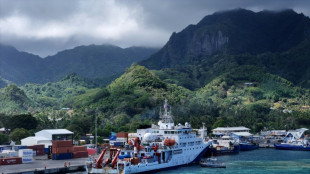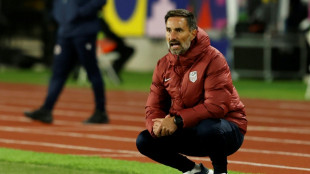-
 Bucks launch NBA Cup title defense with win over Bulls
Bucks launch NBA Cup title defense with win over Bulls
-
Chinese ship scouts deep-ocean floor in South Pacific

-
 Taiwan badminton star Tai Tzu-ying announces retirement
Taiwan badminton star Tai Tzu-ying announces retirement
-
New York City beat Charlotte 3-1 to advance in MLS Cup playoffs

-
 'Almost every day': Japan battles spike in bear attacks
'Almost every day': Japan battles spike in bear attacks
-
MLS Revolution name Mitrovic as new head coach

-
 Trump gives Hungary's Orban one-year Russia oil sanctions reprieve
Trump gives Hungary's Orban one-year Russia oil sanctions reprieve
-
Owners of collapsed Dominican nightclub formally charged

-
 US accuses Iran in plot to kill Israeli ambassador in Mexico
US accuses Iran in plot to kill Israeli ambassador in Mexico
-
New Zealand 'Once Were Warriors' director Tamahori dies

-
 Hungary's Orban wins Russian oil sanctions exemption from Trump
Hungary's Orban wins Russian oil sanctions exemption from Trump
-
More than 1,000 flights cut in US shutdown fallout

-
 Turkey issues genocide arrest warrant against Netanyahu
Turkey issues genocide arrest warrant against Netanyahu
-
Countries agree to end mercury tooth fillings by 2034

-
 Hamilton faces stewards after more frustration
Hamilton faces stewards after more frustration
-
World's tallest teen Rioux sets US college basketball mark

-
 Trump pardons three-time World Series champ Strawberry
Trump pardons three-time World Series champ Strawberry
-
Worries over AI spending, US government shutdown pressure stocks

-
 Verstappen suffers setback in push for fifth title
Verstappen suffers setback in push for fifth title
-
Earth cannot 'sustain' intensive fossil fuel use, Lula tells COP30

-
 Wales boss Tandy expects Rees-Zammit to make bench impact against the Pumas
Wales boss Tandy expects Rees-Zammit to make bench impact against the Pumas
-
James Watson, Nobel prize-winning DNA pioneer, dead at 97

-
 Medical all-clear after anti-Trump package opened at US base
Medical all-clear after anti-Trump package opened at US base
-
Sabalenka beats Anisimova in pulsating WTA Finals semi

-
 Iran unveils monument to ancient victory in show of post-war defiance
Iran unveils monument to ancient victory in show of post-war defiance
-
MLS Revolution name Mitrovic as hew head coach

-
 Brazil court reaches majority to reject Bolsonaro appeal against jail term
Brazil court reaches majority to reject Bolsonaro appeal against jail term
-
Norris grabs pole for Brazilian Grand Prix sprint race

-
 More than 1,200 flights cut across US in govt paralysis
More than 1,200 flights cut across US in govt paralysis
-
NFL Cowboys mourn death of defensive end Kneeland at 24

-
 At COP30, nations target the jet set with luxury flight tax
At COP30, nations target the jet set with luxury flight tax
-
Trump hosts Hungary's Orban, eyes Russian oil sanctions carve-out

-
 All Blacks 'on edge' to preserve unbeaten Scotland run, says Savea
All Blacks 'on edge' to preserve unbeaten Scotland run, says Savea
-
Alpine say Colapinto contract about talent not money

-
 Return of centuries-old manuscripts key to France-Mexico talks
Return of centuries-old manuscripts key to France-Mexico talks
-
Byrne adamant Fiji no longer overawed by England

-
 Ex-footballer Barton guilty over 'grossly offensive' X posts
Ex-footballer Barton guilty over 'grossly offensive' X posts
-
Key nominees for the 2026 Grammy Awards

-
 Brazil court mulls Bolsonaro appeal against jail term
Brazil court mulls Bolsonaro appeal against jail term
-
Rybakina sinks Pegula to reach WTA Finals title match

-
 Earth 'can no longer sustain' intensive fossil fuel use, Lula tells COP30
Earth 'can no longer sustain' intensive fossil fuel use, Lula tells COP30
-
Kendrick Lamar leads Grammy noms with nine

-
 Ex-British soldier fights extradition over Kenyan woman's murder
Ex-British soldier fights extradition over Kenyan woman's murder
-
Kolisi to hit Test century with his children watching

-
 Alex Marquez fastest in practice ahead of Portuguese MotoGP
Alex Marquez fastest in practice ahead of Portuguese MotoGP
-
Will 'war profiteer' Norway come to Ukraine's financial rescue?

-
 Tech selloff drags stocks down on AI bubble fears
Tech selloff drags stocks down on AI bubble fears
-
Blasts at Indonesia school mosque injure more than 50

-
 Contepomi says lead-in to Wales match a 'challenge' for Argentina
Contepomi says lead-in to Wales match a 'challenge' for Argentina
-
Greece woos US energy deals, as eco groups cry foul

Deep ocean targeted for mining is rich in unknown life
A vast area at the bottom of the Pacific Ocean earmarked for controversial deep sea mineral mining is home to thousands of species unknown to science and more complex than previously understood, according to several new studies.
Miners are eyeing an abyssal plain stretching between Hawaii and Mexico, known as the Clarion-Clipperton Zone (CCZ), for the rock-like "nodules" scattered across the seafloor that contain minerals used in clean energy technologies like electric car batteries.
The lightless ocean deep was once considered a virtual underwater desert, but as mining interest has grown scientists have scoured the region exploring its biodiversity, with much of the data over the last decade coming from commercially-funded expeditions.
And the more they look the more they have found, from a giant sea cucumber dubbed the "gummy squirrel" and a shrimp with a set of elongated bristly legs, to the many different tiny worms, crustaceans and mollusks living in the mud.
That has intensified concerns about controversial proposals to mine the deep sea, with the International Seabed Authority on Friday agreeing a two-year roadmap for the adoption of deep sea mining regulations, despite conservationists' calls for a moratorium.
Abyssal plains over three kilometres underwater cover more than half of the planet, but we still know surprisingly little about them.
They are the "last frontier", said marine biologist Erik Simon-Lledo, who led research published Monday in the journal Nature Ecology and Evolution that mapped the distribution of animals in the CCZ and found a more complex set of communities than previously thought.
"Every time we do a new dive we see something new," said Simon-Lledo, of Britain's National Oceanography Centre.
Campaigners say this biodiversity is the true treasure of the deep sea and warn that mining would pose a major threat by churning up huge plumes of previously-undisturbed sediment.
The nodules themselves are also a unique habitat for specialised creatures.
"With the science as it is at the present day, there is no circumstance under which we would support mining of the seabed," said Sophie Benbow of the NGO Fauna and Flora.
- 'Mind-bogglingly vast' -
The Clarion-Clipperton zone has both its age and its size to thank for the unique animals discovered there, scientists say.
The region is "mind-bogglingly vast", said Adrian Glover, of Britain's Natural History Museum, a co-author both on the study with Simon-Lledo and on the first full stocktake of species in the region published in Current Biology in May.
That study found that more than 90 percent of species recorded in the CCZ -- some 5,000 species -- are new to science.
The region, which was considered to be essentially barren before an increase in exploration in the 1970s, is now thought to have a slightly higher diversity than the Indian Ocean, said Glover.
He said sediment sampling devices from the region might only capture 20 specimens each time -- compared to maybe 20,000 in a similar sample in the Antarctic -- but that in the CCZ you have to go much further to find the same creature twice.
Scientists are now also able to use autonomous underwater vehicles to survey the seabed.
These are what helped Simon-Lledo and his colleagues find that corals and brittlestars are common in shallower eastern CCZ regions, but virtually absent in deeper areas, where you see more sea cucumbers, glass sponges and soft-bodied anemones.
He said any future mining regulations would have to take into account that the spread of animals across the area is "more complex than we thought".
- 'Serious harm' -
The nodules likely started as a shard of hard surface -- a shark tooth or a fish ear bone -- that settled on the seabed and slowly grew by attracting minerals that naturally occur in the water at extremely low concentrations, Glover said.
Each one is likely millions of years in the making.
The area is also "food poor", meaning fewer dead organisms drift down to the depths to eventually become part of the seafloor mud. Glover said parts of the CCZ add just a centimetre of sediment per thousand years.
Unlike the North Sea, formed from the last ice age that ended 20,000 years ago, the CCZ is ancient.
"The abyssal plain of the Pacific Ocean has been like that for tens of millions of years -- a cold dark abyssal plain with low sedimentation rates and life there," Glover said.
Because of this, the environment impacted by any mining would be unlikely to recover in human timescales.
"You are basically writing that ecosystem off for probably centuries, maybe thousands of years, because the rate of recovery is so slow," said Michael Norton, Environment Programme Director, the European Academies' Science Advisory Council.
"It's difficult to argue that that is not serious harm."
R.AbuNasser--SF-PST
